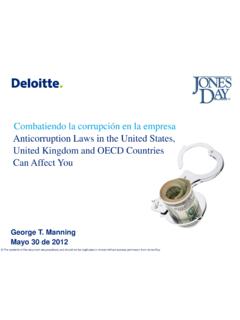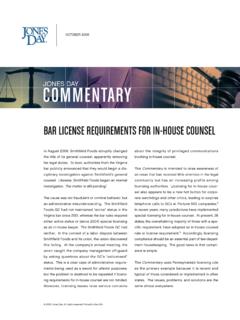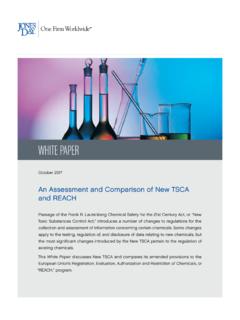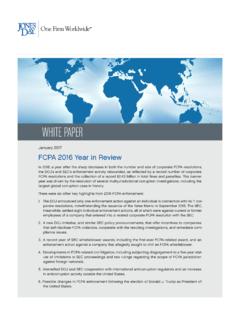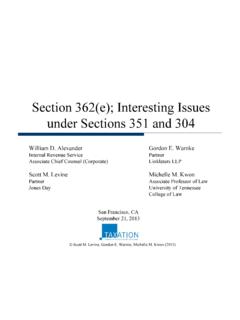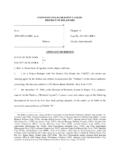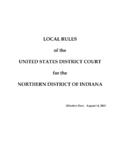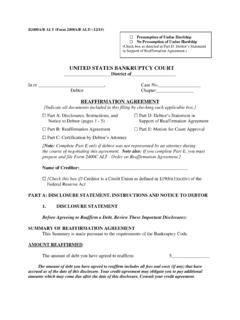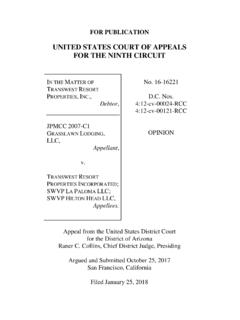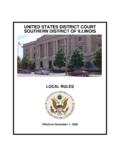Transcription of Comparison of Chapter 11 of the United States …
1 Comparison of Chapter 11 of the United States bankruptcy Codewith The System of Administration in the United Kingdom, The Rescue Procedure in France, Insolvency Proceedings in Germany, and The Extraordinary Administration for Large Insolvent Companies in Italy ContentComparison of Chapter 11 of the United States bankruptcy Codewith Pagethe system of the administration in the United kingdom 5 A Background 6 B Procedure 8 C Moratorium 10 D Lifting the Stay 1 1 E Control 1 F Contracts 14 G Proposals to Creditors 15 H Costs 17 I Exit Routes 18 J Finances 19 K Summary 0the resCUe proCedUre in franCe 1 A Background B Procedure C Moratorium 5 D Lifting the Stay 6 E Control 7 F Contracts 8 G Proposals to Creditors 9 H Costs 1 I Exit Routes J Finances K Summary 4insolvenCy proCeedings in germany 5 A Background 6 B Procedure 7 C Moratorium 8 D Lifting the Stay 9 E Control 40 F Contracts 41 G Proposals to Creditors 4 H Costs 44 I Exit Routes 45 J Finances 46 K Summary 47the extraordinary administration for large insolvent Companies in italy 49 A Background 50 B
2 Procedure 51 C Moratorium 5 D Lifting the Stay 5 E Control 54 F Contracts 55 G Proposals to Creditors 56 H Costs 58 I Exit Routes 59 J Finances 60 K Summary 6145 Comparison of Chapter 11 of the United States bankruptcy Codeand the system of administration in the United kingdom6a BaCkgroUndChapter 11 - Us bankruptcy CodeChapter 1 1 focuses on preserving reorganization or going concern value over liquidation value. As a corollary, Chapter 11 assumes that the most efficacious way to achieve that result is to retain management and enable multiple outcomes either through a plan of reorganization, a series of going concern sales and even a liquidating plan. Chapter 1 1 enables a wide range of proposals to be put into a reorganization plan, in-cluding having the company and its management survive the process. Chapter 11 cases fall into two general categories: the freefall case or a pre-packaged or pre-negotiated the former, relief is sought under Chapter 1 1 of the Bank-ruptcy code without having an agreed exit strategy among the company and at least a critical mass or core group of creditors.
3 The latter is characterized by commencing a Chap-ter 1 1 case following the development of a consensus on the outcome of the case. Under both scenarios, Chapter 11 plans embrace:1. a standalone plan, which essentially connotes that the creditors, secured and unsecured, and , if applicable, the company and its equity-holders, agree on a reorganiza-tion without the intervention of a third party or a sale of the business, relying instead on what may be termed a composition plan under which at least some unsecured creditors agree to accept less than 100% payment or agree to take a combination of debt and equity issued by the reorganized company in return for their claims; or . a plan which effects a sale of all or substantially all of the assets as a going concern and distributes the consider-ation or proceeds of sale to the creditors; . a plan which relies upon a capital infusion from an inves-tor;4. a liquidating plan which sells all of the assets of the company and provides for a distribution of proceeds to creditors;5.
4 A plan which, in part, contemplates a litigation trust to pursue and prosecute causes of action belonging to the company; or6. a combination of the administration - schedule B1 of the insolvency act 1986 The concept of administration was conceived by the Insol-vency Act 1986 as a method of ensuring the survival of the company as a going concern with the benefit of a morato-rium in respect of the administration debts. The aim was to rehabilitate the business of the company and to give it time to reassess its future rather than leaving it to face liquidation or administrative receivership (the process by which the holder of a floating charge over the assets of the company can appoint a receiver to run and ultimately sell the assets). The administration procedure has recently been reformed by the Enterprise Act 00 . They key reform is that an administrative receiver may only be appointed in respect of certain speci-fied cases:1.
5 Capital market transactions if debt is, or is expected to exceed 50m; . Finance projects if debt is or is expected to exceed 50m and there are step in rights; . Utilities projects;4. Public private partnerships;5. Financial Markets Transactions; and6. Registered Social , holders of qualifying floating charges will be given the right to obtain an order for the appointment of an administra-tor on the occurrence of an event of default under the banking facilities - usually a failure to meet a payment deadline but it could be for a breach of another proposals are consistent with the Government s wish to promote a rescue culture in the field of corporate insolvency, and with its preference for insolvency procedures that aim to maximise the benefits for all creditors, rather than for a spe-cific class of interest. The effective abolition of administrative receivership will mean that holders of floating charges will be encouraged to focus less on a disposal of assets as a mean of recouping value (although this option will be open to them un-der the administration procedure), and more on an approach which achieves an outcome that benefits all stakeholders in the debtor company.
6 One of the Government s particular aims is to help owner-managed companies where for those direc-tors saving the company is much more important than selling the assets to a new company, for under the enterprise act 2002 The Enterprise Act 00 became effective on 15 September 00 and (amongst other things):1. virtually abolishes the concept of administrative receiv-ership by preventing holders of floating charges from blocking the appointment of an administrator; . allows administrators to be appointed out of court by the holder of a qualifying floating charge, the directors or the company in certain circumstances. In the UK, directors can incur personal liability for trading whilst insolvent ( wrongful trading ) and must file for an insol-vency process at the time the company cannot avoid insolvency. By filing for administration, this gives the directors breathing space free of creditor pressure to try to put a rescue plan together.
7 Emphasises that the main objective of administration is rescuing the company as a going concern. Only if that primary objective cannot be achieved may the admin-istrator then break up or sell the whole of the business or realise property in order to make a distribution to secured or preferential creditors (see later); and4. the administrator now owes a duty to protect the in-terests of all creditors - compared to administrative receivership where the receiver owed a primary duty to the secured lender who appointed objective of both procedures is the creation of breathing space during which the debtor company is given time to for-mulate plans for a reorganization. Chapter 1 1 also has provisions which enable a company to stabilize its business by, among other things, authorizing the borrowing of loans, the rejection of executory contracts, and the re-negotiation of union and retiree proCedUre Chapter 11 - Us bankruptcy CodeA typical Chapter 1 1 case begins when the debtor company voluntarily files a petition with a bankruptcy court, accompa-nied by:1.
8 A list of creditors; and . a summary of assets and there is no requirement of insolvency . Companies may have a number of reasons, other than insolvency, to file for bankruptcy relief: the company is faced with massive tort liabilities ( Dow Corning when a global settlement with plaintiffs broke down), an adverse outcome in a litigation ( Texaco when faced with a multi-billion dollar damages award), and anticipated liquidity issues ( a number of energy companies).But applications must be in good faith and with the inten-tion of reorganization or to effect a liquidation or sale of the company, and creditors may apply to have petitions dismissed where this is not the case. For example, in the SGL Carbon Corporation case ( 00 F. d 154), the court dismissed the com-pany s Chapter 11 case because of bad faith demonstrated by a lack of reorganization purpose .A large company may also be involuntarily pushed into a Chapter 1 1 case if three creditors holding unsecured non contingent undisputed claims aggregating more than $1 , 00 file an involuntary petition against the company and if the company is generally not paying [its] debts as such debts become due The company may contest the petition and if the above standard is not met, may file suit against the filing creditors for costs and /or reasonable attorneys fees or, if filed in bad faith, damages, including punitive it is the company not the creditors who file for Chapter 1 1 protection (see Section E: Control of the company).
9 How-ever, secured lenders may effectively force a company to file for relief under Chapter 1 1 by threatening to enforce administration - schedule B1 of the insolvency act 1986 Administration can be commenced out of court by a secured creditor who holds a qualifying floating charge , by the com-pany itself or by its directors. Otherwise general creditors must apply to procedureThe application must state that:1. the company is or is likely to become insolvent (on as-sets/liability test or inability to pay debts grounds); AND . it is reasonably likely that the following can be achieved: the rescue of the company as a going concern or as much of its business as is reasonably practicable ; or, if this is not practicable; a better result for the company s creditors as a whole than would be likely if the company were to be wound up; or, if this is not practicable; the realisation of the company s property on a break-up basis in order to make a distribution to one or more secured or preferential creditors, but without unnecessarily harming the interests of unsecured application must be supported by a statement from the proposed administrator confirming that it is reasonably likely that the purpose of the administration will be achieved, providing details of the company s financial position, details of creditors security and any other relevant matters must be of CourtThe holder of a qualifying floating charge may appoint an administrator out of court and the appointment takes effect once the holder of a floating charge has filed the necessary papers at court.
10 As with the court procedure, the proposed administrator must make a statement that the purpose of the administration is reasonably likely to be administrator must satisfy himself that the first two ob-jectives (referred to above) are not practicable, before pro-ceeding with the third objective, namely realising assets for distribution to secured creditors. The company or its directors may also appoint an administrator out of the court procedure, the UK court has discretion as to whether to grant the administration order. Using the out of court route, the holder of a qualifying floating charge is entitled to appoint an administrator as of right, as are the directors and company if there is no holder of a qualifying floating charge or the holder of the qualifying floating charge consents. There are no similar gating or entry issues under Chapter 11. The debtor has a legal right to enter the procedure, although a Chapter 11 case may be dismissed if the court determines that it was filed in bad faith.
